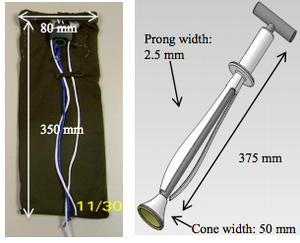
Problem being addressed
Obstructed labor is a major cause of maternal mortality, attributing to 2.1-13.4% of maternal deaths in Africa, Asia, South America, and the Caribbean. The most available treatment options in low-resource settings include cesarean section and assisted vaginal delivery. While assisted vaginal delivery is a viable solution, performing this procedure requires extensive training or the use of a vacuum, a piece of equipment not readily available in developing settings.
Detailed description of the solution[edit | edit source]
This assisted delivery device has two components, an applicator and a fabric extractor. The extractor is made of nylon and spandex, and the applicator includes three prongs in order to secure the device while it is being applied to the baby's head. There is also a drawstring used to secure the extractor to the baby's chin as traction is initially applied and the baby is delivered. A cord lock is used to ensure that the drawstring does not become unsecure. This lock is disengaged once the baby is safely delivered.
Designed by[edit | edit source]
- Designed by: University of Michigan
- Manufacturer (if different):
- Manufacturer location:
When and where it was tested/implemented[edit | edit source]
The usability analysis was done in Ghana in 2011.
Funding Source[edit | edit source]
University of Michigan, National Collegiate Inventors and Innovators Alliance
References[edit | edit source]
Peer-reviewed publication[edit | edit source]
Hessburg, J. P., Murthy, P., Patel, K. D., Ostrowski, D. P., Sienko, K. H. (2012). "An assisted obstetric delivery device for resource limited settings." International Journal for Service Learning in Engineering; 7(2): 1-12. Web. Retrieved November 13, 2013 from here.